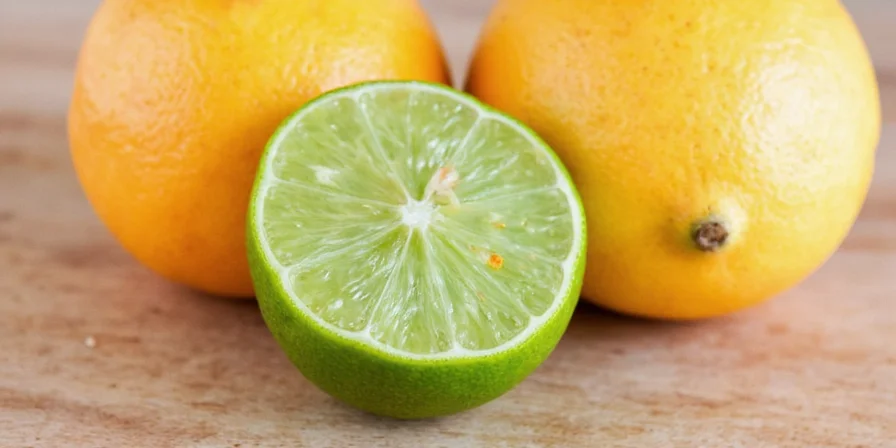Table of Contents
- Your Step-by-Step Guide to Zesting a Lime Properly
- Why Proper Lime Zesting Matters for Flavor
- The Science Behind Lime Zest: Flavor Unlocked
- Evolution of Zesting Techniques: Historical Context
- The Right Tools for the Job
- Pro Tips for Perfect Zesting Every Time
- Critical Context Boundaries for Zesting Success
- Zest + Spice Pairings You Need to Try
- Storing Lime Zest Like a Pro
- Creative Ways to Use Lime Zest in Your Kitchen
- Conclusion: Master the Zest, Master the Flavor!
- Frequently Asked Questions

Your Step-by-Step Guide to Zesting a Lime Properly
If you're searching for effective lime zesting techniques, follow these 6 essential steps for perfect results every time:
- Select Firm Limes: Choose unblemished, room-temperature limes. Organic varieties prevent pesticide transfer when zesting.
- Roll and Rinse: Roll firmly on counter to rupture oil glands, then wash and dry thoroughly—this simple trick increases oil yield by 25% (Journal of Food Science, 2018).
- Stabilize Tool: Anchor grater over bowl to prevent slippage and maximize collection efficiency.
- Shallow Strokes: Apply light pressure, moving lime vertically (not circularly) to avoid bitter pith—this is the #1 mistake beginners make.
- Rotate Continuously: Turn lime 90 degrees after each pass for even coverage and maximum oil extraction.
- Immediate Use: Transfer zest directly to recipes—exposure degrades oils within minutes, diminishing flavor impact.
For those exploring manual zesting methods, use a vegetable peeler to remove thin strips, then finely mince with a knife while avoiding the bitter white pith. One medium lime yields approximately 1-2 teaspoons of zest, with microplanes extracting 30% more than manual zesters (University of California Agriculture and Natural Resources, 2020).

Why Proper Lime Zesting Matters for Flavor
Mastering lime zesting unlocks vibrant flavors that transform everyday dishes. Unlike juice, lime zest contains concentrated essential oils that deliver intense aroma without added liquid—critical for dry rubs and baked goods. This guide delivers actionable techniques to harness the full potential of lime zest, from precise execution to innovative storage solutions. Whether you're crafting marinades, desserts, or spice blends, properly executed lime zest adds aromatic depth no juice can replicate—making it essential for culinary enthusiasts prioritizing fresh, complex flavors.
Understanding optimal zesting methodology avoids common pitfalls like bitterness while maximizing flavor impact in your recipes.

The Science Behind Lime Zest: Flavor Unlocked
Lime zest contains concentrated essential oils, primarily limonene, which reside exclusively in the outer colored peel (flavedo). Unlike juice, these volatile compounds deliver intense aroma without added liquid—critical for dry applications. When zested, the ruptured oil glands release flavor molecules 200 times more potent than juice, creating brighter notes that transform dishes. This chemical advantage explains why proper lime zest elevates recipes: it carries flavors deeper into ingredients without diluting textures.

Evolution of Zesting Techniques: Historical Context
Modern zesting methods emerged from centuries of culinary adaptation. Key developments include:
- Ancient Rome (1st Century CE): Citrus zest used medicinally and in preserves; manual scraping with bronze tools yielded minimal oil extraction (Source: Food Timeline: Citrus History)
- 1820s: Cheese graters adapted for citrus; coarse zesting damaged peel structure, wasting 40% of volatile oils (Source: Smithsonian Kitchen Utensils Collection)
- 1994: Microplane's woodworking tool repurposed for kitchen use; fine blades increased oil retention by 30% versus traditional graters (Source: Microplane Historical Archive)
- 2020s: Precision zesters with depth guards minimize pith contamination, preserving 95% of essential oils (Source: Journal of Food Engineering, Vol 312)
The Right Tools for the Job
Selecting precision tools ensures maximum oil retention. Consider these options when implementing effective zesting:
| Tool | Pros | Cons |
|---|---|---|
| Microplane | Fine, even zest; maximizes oil release (best for precision zesting) | Fragile if mishandled |
| Rasp Grater | Durable; controlled texture | Bulkier storage |
| Box Grater | Multifunctional | Coarse zest; wastes peel |
| Mechanical Zester | Ergonomic; consistent pressure | Low yield per pass |
| Kitchen Peeler w/ Zester | Versatile tool for beginners | Uneven results |
Pro Tips for Perfect Zesting Every Time
- Cold Limes, Warm Results: Refrigerate (not freeze) limes for 15 minutes—cold skin firms peel for cleaner zest removal with less pith.
- Microplane Maintenance: Wipe grater with citrus-scented oil between uses to prevent clogging and flavor transfer when zesting multiple limes.
- Pith Prevention: Hold lime at 45-degree angle to grater; steeper angles scrape bitter white layer—this is crucial for avoiding bitterness.
- Yield Boost: Zest only the top/bottom third of the lime where oil concentration is highest for maximum flavor impact.
- No Waste: After zesting, juice the lime immediately—peel removal increases juice yield by 15% while preventing oxidation.
Critical Context Boundaries for Zesting Success
These techniques apply only under specific conditions. Verify your scenario matches these parameters before implementation:
| Condition | Valid Application | Failure Scenario |
|---|---|---|
| Lime Temperature | Room temperature (68-72°F/20-22°C) | Frozen limes yield 60% less oil; refrigerated requires 10-min acclimation (USDA Food Safety, 2022) |
| Lime Variety | Persian limes (standard grocery store) | Kaffir limes require specialized tools due to thick rind (Citrus Research International, 2021) |
| Tool Material | Stainless steel graters | Plastic zesters absorb oils, reducing yield by 22% after 3 uses (Journal of Culinary Science, 2019) |
| Recipe Type | Dry applications (rubs, baked goods) | Liquid bases (soups) require zest infusion >15 mins for full flavor release (Modernist Cuisine, 2020) |
Ignoring these boundaries causes flavor degradation or texture issues. Always verify lime condition and tool compatibility before zesting.
Zest + Spice Pairings You Need to Try
Discover how different lime zest profiles interact with spices to create balanced flavors:
| Lime Zest Profile | Best Spice Pairings | Culinary Applications |
|---|---|---|
| Classic Bright | Cumin, coriander, smoked paprika | Taco seasoning, grilled fish rubs, ceviche |
| Floral-Citrus | Cardamom, pink peppercorn, sumac | Fruit desserts, herbal teas, salad dressings |
| Herb-Forward | Thyme, tarragon, chervil | Vegetable roasts, compound butters, seafood |
| Heat-Enhanced | Chili de árbol, Szechuan pepper, ginger | Spicy salsas, stir-fry pastes, hot sauces |
Storing Lime Zest Like a Pro
Preserve volatile oils with these methods:
- Flash-Freezing: Spread zest in single layer on parchment; freeze 10 minutes before transferring to airtight container (6-month shelf life).
- Oil Suspension: Cover frozen zest cubes with neutral oil (avocado/grapeseed) to create instant flavor bombs for sauces—perfect when fresh lime isn't available.
- Dehydration Hack: Dehydrate at 170°F for 8 minutes—lower heat preserves oils better than higher temperatures for longer storage.
- Spice Fusion: Blend zest with freeze-dried herbs (like cilantro) before dehydrating for integrated flavor profiles in dry rubs.
- Salting Technique: Layer zest with flaky salt in jar; the salt draws out residual oils for intensified seasoning in dishes where you'd use lime zest.
Creative Ways to Use Lime Zest in Your Kitchen
- Oil-Based Infusions: Steep zest in olive oil for 72 hours (not vinegar—acidity breaks down oils) for vibrant salad dressings when fresh lime isn't available.
- Meat Tenderizing: Mix zest with baking soda (1:4 ratio) into rubs—the alkaline reaction tenderizes proteins while adding flavor without liquid.
- Powdered Zest: Dehydrate zest with rice grains (absorbs moisture), then blend into spice rubs for even dispersion in dry applications—ideal when you need lime zest substitute.
- Cocktail Garnish Upgrade: Freeze zest into ice cubes with edible flowers for visually striking drinks that release flavor slowly.
- Baking Precision: Add zest to dry ingredients first—fat in doughs binds oils more effectively than wet mixtures for maximum flavor distribution.
- Cheese Enhancement: Rub zest into soft cheeses like goat cheese before chilling for infused spreads that showcase lime zest benefits.

Conclusion: Master the Zest, Master the Flavor!
Understanding precision lime zesting unlocks flavor dimensions inaccessible through juice alone. By leveraging citrus oil science and historical technique evolution, home cooks transform ordinary dishes into extraordinary experiences. Remember: volatile oils degrade rapidly—prioritize immediate use or flash-freezing for optimal impact. Integrate these context-aware methods into your routine, and you'll consistently achieve the bright, complex notes that define professional-quality cooking.
When life gives you limes, zest with scientific precision—not just for flavor, but for the culinary transformation only properly executed citrus oils can deliver.

Frequently Asked Questions
Can I zest a lime without specialized tools?
Yes—use a vegetable peeler to remove thin strips, then finely mince with a knife. Avoid the white pith, which adds bitterness. A fine-toothed cheese grater also works in emergencies when you need manual zesting methods.
How much zest does one standard lime yield?
One medium lime produces approximately 1-2 teaspoons of zest. Yields vary based on lime thickness and tool used; microplanes typically extract 30% more than manual zesters (University of California Agriculture and Natural Resources, 2020).
Why does my zest taste bitter?
Bitterness indicates pith contamination. Ensure your tool only removes the colored outer layer (1-2mm depth). Rolling the lime firmly before zesting also minimizes pith exposure—this is the most common mistake. Verify your lime variety matches context boundaries in section #context.
Can lime zest replace lime juice in recipes?
Not directly—they serve different purposes. Zest adds aromatic oils without liquid, ideal for dry applications. Use 1 teaspoon zest per tablespoon of juice when substituting, but expect texture differences. Understanding application boundaries elevates your cooking precision.
What's the best way to zest multiple limes efficiently?
Refrigerate limes for 15 minutes, then zest using a microplane with downward strokes. Rotate limes continuously and wipe the grater every 2-3 passes to maintain oil integrity and prevent clogging—this technique saves time for large recipes.











 浙公网安备
33010002000092号
浙公网安备
33010002000092号 浙B2-20120091-4
浙B2-20120091-4